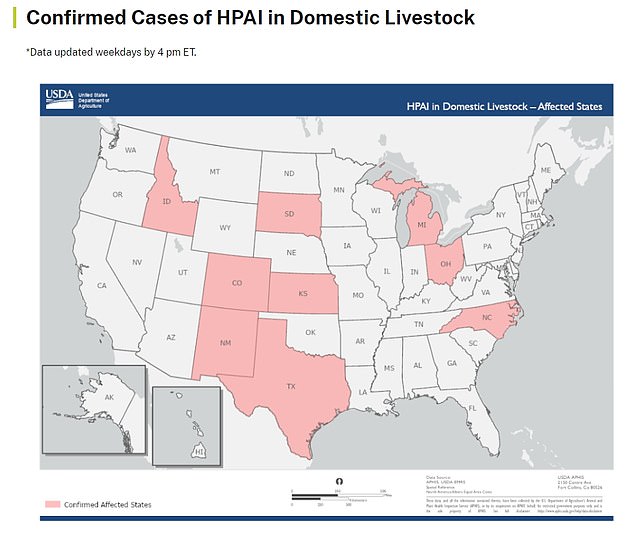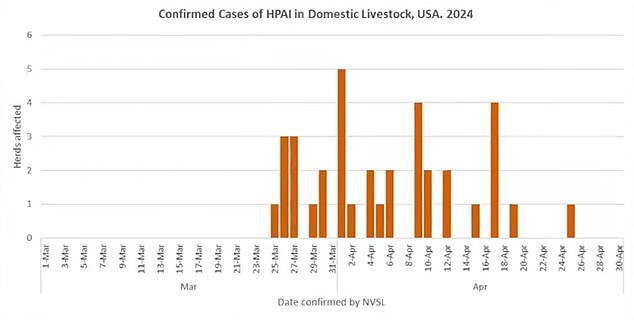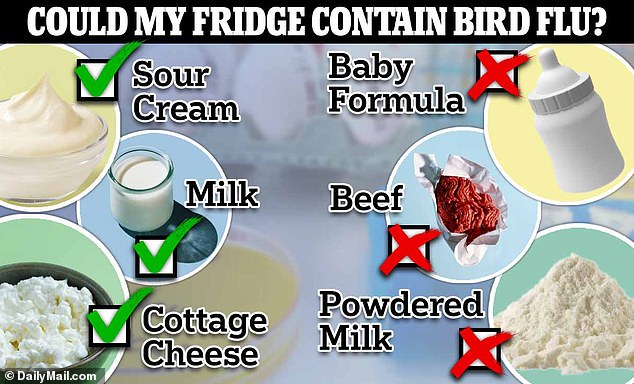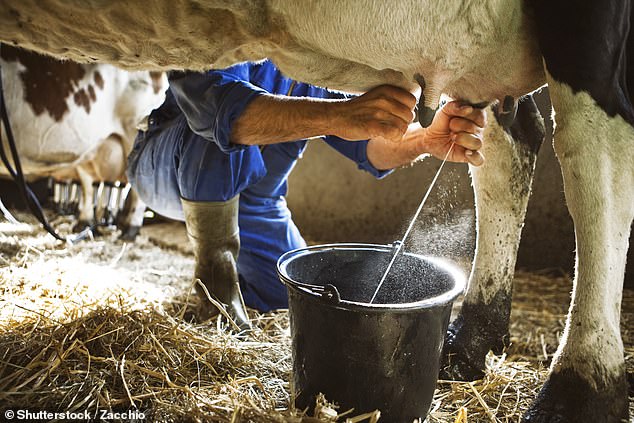About 70 Americans in Colorado are being monitored for bird flu due to possible exposure.
dairy farm workers They will be tested for the virus if they show any symptoms, although this has not been the case so far, local health officials said.
Details about their ages, gender and conditions have not been revealed, but they all worked on a farm in the northeastern part of the state.
So far, only one person – a Texas farmer – has tested positive for the H5N1 virus in this outbreak, but the CDC fears many more could be infected and not come forward.
It comes as the top FDA official revealed that the agency is preparing for a human bird flu pandemic that could kill one in four of those infected.
About 70 Americans in Colorado are being monitored for bird flu due to possible exposure.

The map above shows states that have reported avian flu infections in dairy herds.
Dr. Robert Califf, the FDA’s chief commissioner, told a Senate committee that officials were drawing up plans to deploy testing, antiviral drugs and vaccines in case the virus jumps to humans and causes a large-scale outbreak.
But he stressed that the risk of it spreading to people is still low.
“This virus, like all viruses, is mutating,” he told policymakers. “We need to continue to prepare for the possibility that it could reach humans.”
“(The) real concern is that it jumps into the human lungs where, when that has happened in other parts of the world… the mortality rate has been 25 percent.”
Colorado officials said it was still unclear exactly how or when workers were potentially exposed, but bird flu was detected in the cow herd in late April.
“We are still putting the pieces of the puzzle together,” Colorado State Veterinarian Maggie Baldwin said in a public Zoom meeting on May 8.
Texas has tested about 20 dairy workers with flu symptoms, with one positive test, while Idaho tested one person and New Mexico said it had tested three people.
But the CDC says states and farms have been reluctant to cooperate with the agency, because farmers are worried about financial losses if their livestock are found to be infected.
After causing a record outbreak in birds in recent years, H5N1 appears to be spreading in livestock for the first time.
So far, a total of 36 farms in nine states have detected the virus among their dairy herds. Only one of the 36 daily herds is in Colorado.
As the virus spreads, particularly between two different species, it acquires more mutations that may allow it to infect people more easily.
Fragments of the virus have already been detected in products such as one in five supermarket milks, as well as cottage cheese and sour cream.
But officials say they are still safe to consume because the virus they contain is inactivated during the pasteurization process.

The graph above shows dairy herds that tested positive for bird flu over time. Authorities fear this will bring the virus one step closer to infecting humans.

A tick indicates foods that tested positive for bird flu, while a cross indicates those that were tested for bird flu but were not found to contain the virus.
Dairy farmers work closely with raw milk, which contains a high concentration of bird flu when produced by infected cattle.
Only two humans in the US have tested positive for bird flu, and both were in close contact with animals infected with the virus.
There have been no signs in any of the cases that the individuals transmitted the disease to others.
Some scientists suspect that bird flu can spread when cows are milked, as equipment can become infected or the virus can enter the air during cleaning.
People who have close, prolonged contact with infected animals can become infected when the virus enters through the eyes or mouth, or when they inhale droplets through the nose.
It comes after CDC officials reaffirmed their warning that bird flu had “pandemic potential” in a new report.
In an article in the New England Journal of Medicine, they made the warning in a section about rolling out vaccines if the virus spreads to humans.
Also last week, a separate U.S. Department of Agriculture study released genetic data showing that the H5N1 strain sweeping dairy farms had acquired dozens of new mutations.
These changes could make the strain more likely to spread from cows to other animals, including people, and make the virus resistant to antivirals.

